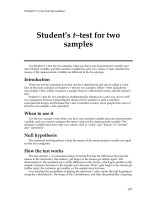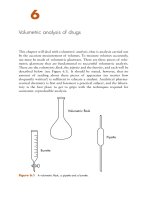Ebook a heat transfer textbook 3rd edition part2
Bạn đang xem bản rút gọn của tài liệu. Xem và tải ngay bản đầy đủ của tài liệu tại đây (8.5 MB, 484 trang )
Part III
Convective Heat Transfer
267
6.
Laminar and turbulent boundary
layers
In cold weather, if the air is calm, we are not so much chilled as when there
is wind along with the cold; for in calm weather, our clothes and the air
entangled in them receive heat from our bodies; this heat. . .brings them
nearer than the surrounding air to the temperature of our skin. But in
windy weather, this heat is prevented. . .from accumulating; the cold air,
by its impulse. . .both cools our clothes faster and carries away the warm
air that was entangled in them.
notes on “The General Effects of Heat”, Joseph Black, c. 1790s
6.1
Some introductory ideas
Joseph Black’s perception about forced convection (above) represents a
very correct understanding of the way forced convective cooling works.
When cold air moves past a warm body, it constantly sweeps away warm
air that has become, as Black put it, “entangled” with the body and replaces it with cold air. In this chapter we learn to form analytical descriptions of these convective heating (or cooling) processes.
Our aim is to predict h and h, and it is clear that such predictions
must begin in the motion of fluid around the bodies that they heat or
cool. It is by predicting such motion that we will be able to find out how
much heat is removed during the replacement of hot fluid with cold, and
vice versa.
Flow boundary layer
Fluids flowing past solid bodies adhere to them, so a region of variable
velocity must be built up between the body and the free fluid stream, as
269
Laminar and turbulent boundary layers
270
Figure 6.1
§6.1
A boundary layer of thickness δ.
indicated in Fig. 6.1. This region is called a boundary layer, which we will
often abbreviate as b.l. The b.l. has a thickness, δ. The boundary layer
thickness is arbitrarily defined as the distance from the wall at which
the flow velocity approaches to within 1% of u∞ . The boundary layer
is normally very thin in comparison with the dimensions of the body
immersed in the flow.1
The first step that has to be taken before h can be predicted is the
mathematical description of the boundary layer. This description was
first made by Prandtl2 (see Fig. 6.2) and his students, starting in 1904,
and it depended upon simplifications that followed after he recognized
how thin the layer must be.
The dimensional functional equation for the boundary layer thickness
on a flat surface is
δ = fn(u∞ , ρ, µ, x)
where x is the length along the surface and ρ and µ are the fluid density
in kg/m3 and the dynamic viscosity in kg/m·s. We have five variables in
1
We qualify this remark when we treat the b.l. quantitatively.
Prandtl was educated at the Technical University in Munich and finished his doctorate there in 1900. He was given a chair in a new fluid mechanics institute at Göttingen
University in 1904—the same year that he presented his historic paper explaining the
boundary layer. His work at Göttingen, during the period up to Hitler’s regime, set the
course of modern fluid mechanics and aerodynamics and laid the foundations for the
analysis of heat convection.
2
Some introductory ideas
§6.1
271
Figure 6.2 Ludwig Prandtl (1875–1953).
(Courtesy of Appl. Mech. Rev. [6.1])
kg, m, and s, so we anticipate two pi-groups:
δ
= fn(Rex )
x
Rex ≡
u∞ x
ρu∞ x
=
µ
ν
(6.1)
where ν is the kinematic viscosity µ/ρ and Rex is called the Reynolds
number. It characterizes the relative influences of inertial and viscous
forces in a fluid problem. The subscript on Re—x in this case—tells
what length it is based upon.
We discover shortly that the actual form of eqn. (6.1) for a flat surface,
where u∞ remains constant, is
4.92
δ
=
x
Rex
(6.2)
which means that if the velocity is great or the viscosity is low, δ/x will
be relatively small. Heat transfer will be relatively high in such cases. If
the velocity is low, the b.l. will be relatively thick. A good deal of nearly
272
Laminar and turbulent boundary layers
§6.1
Osborne Reynolds (1842 to 1912)
Reynolds was born in Ireland but he
taught at the University of Manchester.
He was a significant contributor to the
subject of fluid mechanics in the late
19th C. His original laminar-toturbulent flow transition experiment,
pictured below, was still being used as
a student experiment at the University
of Manchester in the 1970s.
Figure 6.3 Osborne Reynolds and his laminar–turbulent flow
transition experiment. (Detail from a portrait at the University
of Manchester.)
stagnant fluid will accumulate near the surface and be “entangled” with
the body, although in a different way than Black envisioned it to be.
The Reynolds number is named after Osborne Reynolds (see Fig. 6.3),
who discovered the laminar–turbulent transition during fluid flow in a
tube. He injected ink into a steady and undisturbed flow of water and
found that, beyond a certain average velocity, uav , the liquid streamline
marked with ink would become wobbly and then break up into increasingly disorderly eddies, and it would finally be completely mixed into the
Some introductory ideas
§6.1
273
Figure 6.4 Boundary layer on a long, flat surface with a sharp
leading edge.
water, as is suggested in the sketch.
To define the transition, we first note that (uav )crit , the transitional
value of the average velocity, must depend on the pipe diameter, D, on
µ, and on ρ—four variables in kg, m, and s. There is therefore only one
pi-group:
Recritical ≡
ρD(uav )crit
µ
(6.3)
The maximum Reynolds number for which fully developed laminar flow
in a pipe will always be stable, regardless of the level of background noise,
is 2100. In a reasonably careful experiment, laminar flow can be made
to persist up to Re = 10, 000. With enormous care it can be increased
still another order of magnitude. But the value below which the flow will
always be laminar—the critical value of Re—is 2100.
Much the same sort of thing happens in a boundary layer. Figure 6.4
shows fluid flowing over a plate with a sharp leading edge. The flow is
laminar up to a transitional Reynolds number based on x:
Rexcritical =
u∞ xcrit
ν
(6.4)
At larger values of x the b.l. exhibits sporadic vortexlike instabilities over
a fairly long range, and it finally settles into a fully turbulent b.l.
274
Laminar and turbulent boundary layers
§6.1
For the boundary layer shown, Rexcritical = 3.5 × 105 , but in general the
critical Reynolds number depends strongly on the amount of turbulence
in the freestream flow over the plate, the precise shape of the leading
edge, the roughness of the wall, and the presence of acoustic or structural vibrations [6.2, §5.5]. On a flat plate, a boundary layer will remain
laminar even when such disturbances are very large if Rex ≤ 6 × 104 .
With relatively undisturbed conditions, transition occurs for Rex in the
range of 3 × 105 to 5 × 105 , and in very careful laboratory experiments,
turbulent transition can be delayed until Rex ≈ 3 × 106 or so. Turbulent
transition is essentially always complete before Rex = 4×106 and usually
much earlier.
These specifications of the critical Re are restricted to flat surfaces. If
the surface is curved away from the flow, as shown in Fig. 6.1, turbulence
might be triggered at much lower values of Rex .
Thermal boundary layer
If the wall is at a temperature Tw , different from that of the free stream,
T∞ , there is a thermal boundary layer thickness, δt —different from the
flow b.l. thickness, δ. A thermal b.l. is pictured in Fig. 6.5. Now, with reference to this picture, we equate the heat conducted away from the wall
by the fluid to the same heat transfer expressed in terms of a convective
heat transfer coefficient:
−kf
∂T
∂y
= h(Tw − T∞ )
(6.5)
y=0
conduction
into the fluid
where kf is the conductivity of the fluid. Notice two things about this
result. In the first place, it is correct to express heat removal at the wall
using Fourier’s law of conduction, because there is no fluid motion in the
direction of q. The other point is that while eqn. (6.5) looks like a b.c. of
the third kind, it is not. This condition defines h within the fluid instead
of specifying it as known information on the boundary. Equation (6.5)
can be arranged in the form
∂
Tw − T
Tw − T ∞
∂(y/L)
=
y/L=0
hL
= NuL , the Nusselt number
kf
(6.5a)
§6.1
Some introductory ideas
275
Figure 6.5 The thermal boundary layer
during the flow of cool fluid over a warm
plate.
where L is a characteristic dimension of the body under consideration—
the length of a plate, the diameter of a cylinder, or [if we write eqn. (6.5)
at a point of interest along a flat surface] Nux ≡ hx/kf . From Fig. 6.5 we
see immediately that the physical significance of Nu is given by
NuL =
L
δt
(6.6)
In other words, the Nusselt number is inversely proportional to the thickness of the thermal b.l.
The Nusselt number is named after Wilhelm Nusselt,3 whose work on
convective heat transfer was as fundamental as Prandtl’s was in analyzing
the related fluid dynamics (see Fig. 6.6).
We now turn to the detailed evaluation of h. And, as the preceding
remarks make very clear, this evaluation will have to start with a development of the flow field in the boundary layer.
3
Nusselt finished his doctorate in mechanical engineering at the Technical University in Munich in 1907. During an indefinite teaching appointment at Dresden (1913 to
1917) he made two of his most important contributions: He did the dimensional analysis of heat convection before he had access to Buckingham and Rayleigh’s work. In so
doing, he showed how to generalize limited data, and he set the pattern of subsequent
analysis. He also showed how to predict convective heat transfer during film condensation. After moving about Germany and Switzerland from 1907 until 1925, he was
named to the important Chair of Theoretical Mechanics at Munich. During his early
years in this post, he made seminal contributions to heat exchanger design methodology. He held this position until 1952, during which time his, and Germany’s, great
influence in heat transfer and fluid mechanics waned. He was succeeded in the chair
by another of Germany’s heat transfer luminaries, Ernst Schmidt.
276
Laminar and turbulent boundary layers
§6.2
Figure 6.6 Ernst Kraft Wilhelm Nusselt
(1882–1957). This photograph, provided
by his student, G. Lück, shows Nusselt at
the Kesselberg waterfall in 1912. He was
an avid mountain climber.
6.2
Laminar incompressible boundary layer on a flat
surface
We predict the boundary layer flow field by solving the equations that
express conservation of mass and momentum in the b.l. Thus, the first
order of business is to develop these equations.
Conservation of mass—The continuity equation
A two- or three-dimensional velocity field can be expressed in vectorial
form:
u = iu + jv + kw
where u, v, and w are the x, y, and z components of velocity. Figure 6.7
shows a two-dimensional velocity flow field. If the flow is steady, the
paths of individual particles appear as steady streamlines. The streamlines can be expressed in terms of a stream function, ψ(x, y) = constant, where each value of the constant identifies a separate streamline,
as shown in the figure.
The velocity, u, is directed along the streamlines so that no flow can
cross them. Any pair of adjacent streamlines thus resembles a heat flow
§6.2
Laminar incompressible boundary layer on a flat surface
Figure 6.7 A steady, incompressible, two-dimensional flow
field represented by streamlines, or lines of constant ψ.
channel in a flux plot (Section 5.7); such channels are adiabatic—no heat
flow can cross them. Therefore, we write the equation for the conservation of mass by summing the inflow and outflow of mass on two faces of
a triangular element of unit depth, as shown in Fig. 6.7:
ρv dx − ρu dy = 0
(6.7)
If the fluid is incompressible, so that ρ = constant along each streamline,
then
−v dx + u dy = 0
(6.8)
But we can also differentiate the stream function along any streamline,
ψ(x, y) = constant, in Fig. 6.7:
dψ =
∂ψ
∂x
y
dx +
∂ψ
∂y
dy = 0
(6.9)
x
If we compare eqns. (6.8) and (6.9), we immediately see that the coefficients of dx and dy must be the same, so
v=−
∂ψ
∂x
and
y
u=
∂ψ
∂y
(6.10)
x
277
278
Laminar and turbulent boundary layers
§6.2
Furthermore,
∂2ψ
∂2ψ
=
∂y∂x
∂x∂y
so it follows that
∂v
∂u
+
=0
∂x
∂y
(6.11)
This is called the two-dimensional continuity equation for incompressible flow, because it expresses mathematically the fact that the flow is
continuous; it has no breaks in it. In three dimensions, the continuity
equation for an incompressible fluid is
∇·u=
∂v
∂w
∂u
=0
+
+
∂z
∂x
∂y
Example 6.1
Fluid moves with a uniform velocity, u∞ , in the x-direction. Find the
stream function and see if it gives plausible behavior (see Fig. 6.8).
Solution. u = u∞ and v = 0. Therefore, from eqns. (6.10)
u∞ =
∂ψ
∂y
and
x
0=
∂ψ
∂x
y
Integrating these equations, we get
ψ = u∞ y + fn(x)
and
ψ = 0 + fn(y)
Comparing these equations, we get fn(x) = constant and fn(y) =
u∞ y+ constant, so
ψ = u∞ y + constant
This gives a series of equally spaced, horizontal streamlines, as we would
expect (see Fig. 6.8). We set the arbitrary constant equal to zero in the
figure.
§6.2
Laminar incompressible boundary layer on a flat surface
Figure 6.8 Streamlines in a uniform
horizontal flow field, ψ = u∞ y.
Conservation of momentum
The momentum equation in a viscous flow is a complicated vectorial expression called the Navier-Stokes equation. Its derivation is carried out
in any advanced fluid mechanics text (see, e.g., [6.3, Chap. III]). We shall
offer a very restrictive derivation of the equation—one that applies only
to a two-dimensional incompressible b.l. flow, as shown in Fig. 6.9.
Here we see that shear stresses act upon any element such as to continuously distort and rotate it. In the lower part of the figure, one such
element is enlarged, so we can see the horizontal shear stresses4 and
the pressure forces that act upon it. They are shown as heavy arrows.
We also display, as lighter arrows, the momentum fluxes entering and
leaving the element.
Notice that both x- and y-directed momentum enters and leaves the
element. To understand this, one can envision a boxcar moving down
the railroad track with a man standing, facing its open door. A child
standing at a crossing throws him a baseball as the car passes. When
he catches the ball, its momentum will push him back, but a component
of momentum will also jar him toward the rear of the train, because
of the relative motion. Particles of fluid entering element A will likewise
influence its motion, with their x components of momentum carried into
the element by both components of flow.
The velocities must adjust themselves to satisfy the principle of conservation of linear momentum. Thus, we require that the sum of the
external forces in the x-direction, which act on the control volume, A,
must be balanced by the rate at which the control volume, A, forces x4
The stress, τ, is often given two subscripts. The first one identifies the direction
normal to the plane on which it acts, and the second one identifies the line along which
it acts. Thus, if both subscripts are the same, the stress must act normal to a surface—it
must be a pressure or tension instead of a shear stress.
279
280
Laminar and turbulent boundary layers
§6.2
Figure 6.9 Forces acting in a two-dimensional incompressible
boundary layer.
directed momentum out. The external forces, shown in Fig. 6.9, are
τyx +
∂τyx
∂p
dy dx − τyx dx + p dy − p +
dx
∂y
∂x
=
dy
∂τyx
∂p
−
∂y
∂x
dx dy
The rate at which A loses x-directed momentum to its surroundings is
ρu2 +
∂ρu2
dx
∂x
dy − ρu2 dy + u(ρv) +
− ρuv dx =
∂ρuv
dy
∂y
dx
∂ρuv
∂ρu2
+
∂x
∂y
dx dy
Laminar incompressible boundary layer on a flat surface
§6.2
We equate these results and obtain the basic statement of conservation of x-directed momentum for the b.l.:
∂τyx
dp
dy dx −
dx dy =
∂y
dx
∂ρuv
∂ρu2
+
∂x
∂y
dx dy
The shear stress in this result can be eliminated with the help of Newton’s
law of viscous shear:
τyx = µ
∂u
∂y
so the momentum equation becomes
∂
∂y
µ
∂u
∂y
−
dp
=
dx
∂ρu2
∂ρuv
+
∂x
∂y
Finally, we remember that the analysis is limited to ρ constant, and
we limit use of the equation to temperature ranges in which µ constant.
Then
1 dp
∂2u
∂uv
∂u2
=−
+ν
+
∂y
ρ dx
∂y 2
∂x
(6.12)
This is one form of the steady, two-dimensional, incompressible boundary layer momentum equation. Although we have taken ρ constant, a
more complete derivation reveals that the result is valid for compressible flow as well. If we multiply eqn. (6.11) by u and subtract the result
from the left-hand side of eqn. (6.12), we obtain a second form of the
momentum equation:
u
∂u
1 dp
∂2u
∂u
+v
=−
+ν
∂x
∂y
ρ dx
∂y 2
(6.13)
Equation (6.13) has a number of so-called boundary layer approximations built into it:
•
∂u/∂x is generally
• v is generally
• p ≠ fn(y)
u.
∂u/∂y .
281
Laminar and turbulent boundary layers
282
§6.2
The Bernoulli equation for the free stream flow just above the boundary layer where there is no viscous shear,
u2
p
+ ∞ = constant
ρ
2
can be differentiated and used to eliminate the pressure gradient,
1 dp
du∞
= −u∞
dx
ρ dx
so from eqn. (6.12):
∂2u
∂(uv)
du∞
∂u2
= u∞
+ν
+
∂y
dx
∂y 2
∂x
(6.14)
And if there is no pressure gradient in the flow—if p and u∞ are constant
as they would be for flow past a flat plate—then eqns. (6.12), (6.13), and
(6.14) become
∂(uv)
∂u
∂u
∂2u
∂u2
+
=u
+v
=ν
∂x
∂y
∂x
∂y
∂y 2
(6.15)
Predicting the velocity profile in the laminar boundary layer
without a pressure gradient
Exact solution. Two strategies for solving eqn. (6.15) for the velocity
profile have long been widely used. The first was developed by Prandtl’s
student, H. Blasius,5 before World War I. It is exact, and we shall sketch it
only briefly. First we introduce the stream function, ψ, into eqn. (6.15).
This reduces the number of dependent variables from two (u and v) to
just one—namely, ψ. We do this by substituting eqns. (6.10) in eqn. (6.15):
∂ψ ∂ 2 ψ
∂3ψ
∂ψ ∂ 2 ψ
−
=
ν
∂x ∂y 2
∂y 3
∂y ∂y∂x
(6.16)
It turns out that eqn. (6.16) can be converted into an ordinary d.e.
with the following change of variables:
ψ(x, y) ≡
5
√
u∞ νx f (η)
where
η≡
u∞
y
νx
(6.17)
Blasius achieved great fame for many accomplishments in fluid mechanics and then
gave it up. He is quoted as saying: “I decided that I had no gift for it; all of my ideas
came from Prandtl.”
§6.2
Laminar incompressible boundary layer on a flat surface
where f (η) is an as-yet-undertermined function. [This transformation is
rather similar to the one that we used to make an ordinary d.e. of the
heat conduction equation, between eqns. (5.44) and (5.45).] After some
manipulation of partial derivatives, this substitution gives (Problem 6.2)
f
d3 f
d2 f
+
2
=0
dη2
dη3
(6.18)
and
1
v
=
2
u∞ ν/x
df
u
=
u∞
dη
η
df
−f
dη
(6.19)
The boundary conditions for this flow are
u(y = 0) = 0
or
u(y = ∞) = u∞
v(y = 0) = 0
df
dη
η=0
df
dη
⎫
⎪
⎪
=0 ⎪
⎪
⎪
⎪
⎪
⎪
⎬
=1 ⎪
⎪
⎪
⎪
⎪
η=∞
⎪
⎪
⎪
or f (η = 0) = 0 ⎭
or
(6.20)
The solution of eqn. (6.18) subject to these b.c.’s must be done numerically. (See Problem 6.3.)
The solution of the Blasius problem is listed in Table 6.1, and the
dimensionless velocity components are plotted in Fig. 6.10. The u component increases from zero at the wall (η = 0) to 99% of u∞ at η = 4.92.
Thus, the b.l. thickness is given by
4.92 =
δ
νx/u∞
or, as we anticipated earlier [eqn. (6.2)],
δ
=
x
4.92
4.92
=
Rex
u∞ x/ν
Concept of similarity. The exact solution for u(x, y) reveals a most
useful fact—namely, that u can be expressed as a function of a single
variable, η:
u
= f (η) = f
u∞
y
u∞
νx
283
284
Laminar and turbulent boundary layers
§6.2
Table 6.1 Exact velocity profile in the boundary layer on a flat
surface with no pressure gradient
y u∞ /νx
η
0.00
0.20
0.40
0.60
0.80
1.00
2.00
3.00
4.00
4.918
6.00
8.00
f (η)
0.00000
0.00664
0.02656
0.05974
0.10611
0.16557
0.65003
1.39682
2.30576
3.20169
4.27964
6.27923
u u∞
v x/νu∞
f (η)
(ηf − f ) 2
f (η)
0.00000
0.06641
0.13277
0.19894
0.26471
0.32979
0.62977
0.84605
0.95552
0.99000
0.99898
1.00000−
0.00000
0.00332
0.01322
0.02981
0.05283
0.08211
0.30476
0.57067
0.75816
0.83344
0.85712
0.86039
0.33206
0.33199
0.33147
0.33008
0.32739
0.32301
0.26675
0.16136
0.06424
0.01837
0.00240
0.00001
This is called a similarity solution. To see why, we solve eqn. (6.2) for
4.92
u∞
=
νx
δ(x)
and substitute this in f (y u∞ /νx). The result is
f =
u
y
= fn
u∞
δ(x)
(6.21)
The velocity profile thus has the same shape with respect to the b.l.
thickness at each x-station. We say, in other words, that the profile is
similar at each station. This is what we found to be true for conduction
√
into a semi-infinite region. In that case [recall eqn. (5.51)], x/ t always
had the same value at the outer limit of the thermally disturbed region.
Boundary layer similarity makes it especially easy to use a simple
approximate method for solving other b.l. problems. This method, called
the momentum integral method, is the subject of the next subsection.
Example 6.2
Air at 27◦ C blows over a flat surface with a sharp leading edge at
1
1.5 m/s. Find the b.l. thickness 2 m from the leading edge. Check the
b.l. assumption that u
v at the trailing edge.
Laminar incompressible boundary layer on a flat surface
§6.2
Figure 6.10 The dimensionless velocity components in a laminar boundary layer.
Solution. The dynamic and kinematic viscosities are µ = 1.853 ×
10−5 kg/m·s and ν = 1.566 × 10−5 m2 /s. Then
Rex =
1.5(0.5)
u∞ x
=
= 47, 893
1.566 × 10−5
ν
The Reynolds number is low enough to permit the use of a laminar
flow analysis. Then
δ=
4.92x
4.92(0.5)
= 0.01124 = 1.124 cm
=
Rex
47, 893
(Remember that the b.l. analysis is only valid if δ/x
1. In this case,
δ/x = 1.124/50 = 0.0225.) From Fig. 6.10 or Table 6.1, we observe
that v/u is greatest beyond the outside edge of the b.l, at large η.
Using data from Table 6.1 at η = 8, v at x = 0.5 m is
v=
0.8604
= 0.8604
x/νu∞
(1.566)(10−5 )(1.5)
(0.5)
= 0.00590 m/s
285
Laminar and turbulent boundary layers
286
§6.2
or, since u/u∞ → 1 at large η
v
0.00590
v
=
= 0.00393
=
u
u∞
1.5
Since v grows larger as x grows smaller, the condition v
u is not satisfied very near the leading edge. There, the b.l. approximations themselves break down. We say more about this breakdown after eqn. (6.34).
Momentum integral method.6 A second method for solving the b.l. momentum equation is approximate and much easier to apply to a wide
range of problems than is any exact method of solution. The idea is this:
We are not really interested in the details of the velocity or temperature
profiles in the b.l., beyond learning their slopes at the wall. [These slopes
give us the shear stress at the wall, τw = µ(∂u/∂y)y=0 , and the heat
flux at the wall, qw = −k(∂T /∂y)y=0 .] Therefore, we integrate the b.l.
equations from the wall, y = 0, to the b.l. thickness, y = δ, to make ordinary d.e.’s of them. It turns out that while these much simpler equations
do not reveal anything new about the temperature and velocity profiles,
they do give quite accurate explicit equations for τw and qw .
Let us see how this procedure works with the b.l. momentum equation. We integrate eqn. (6.15), as follows, for the case in which there is
no pressure gradient (dp/dx = 0):
δ
0
∂u2
dy +
∂x
δ
0
∂(uv)
dy = ν
∂y
δ
0
∂2u
dy
∂y 2
At y = δ, u can be approximated as the free stream value, u∞ , and other
quantities can also be evaluated at y = δ just as though y were infinite:
⎡
⎤
δ
0
∂u2
⎢
dy + (uv)y=δ − (uv)y=0 = ν ⎣
∂x
=u∞ v∞
∂u
∂y
−
y=δ
=0
∂u
∂y
⎥
⎦
y=0
0
(6.22)
The continuity equation (6.11) can be integrated thus:
δ
v∞ − vy=0 = −
0
∂u
dy
∂x
(6.23)
=0
6
This method was developed by Pohlhausen, von Kármán, and others. See the discussion in [6.3, Chap. XII].
Laminar incompressible boundary layer on a flat surface
§6.2
Multiplying this by u∞ gives
δ
u ∞ v∞ = −
0
∂uu∞
dy
∂x
Using this result in eqn. (6.22), we obtain
δ
0
∂u
∂
[u(u − u∞ )] dy = −ν
∂x
∂y
y=0
Finally, we note that µ(∂u/∂y)y=0 is the shear stress on the wall, τw =
τw (x only), so this becomes7
d
dx
δ(x)
0
u(u − u∞ ) dy = −
τw
ρ
(6.24)
Equation (6.24) expresses the conservation of linear momentum in
integrated form. It shows that the rate of momentum loss caused by the
b.l. is balanced by the shear force on the wall. When we use it in place of
eqn. (6.15), we are said to be using an integral method. To make use of
eqn. (6.24), we first nondimensionalize it as follows:
d
dx
1
δ
0
u
u∞
y
u
−1 d
u∞
δ
=−
ν ∂(u/u∞ )
u∞ δ ∂(y/δ)
y=0
τw (x)
1
=−
2 ≡ − 2 Cf (x)
ρu∞
(6.25)
where τw /(ρu2∞ /2) is defined as the skin friction coefficient, Cf .
Equation (6.25) will be satisfied precisely by the exact solution (Problem 6.4) for u/u∞ . However, the point is to use eqn. (6.25) to determine
u/u∞ when we do not already have an exact solution. To do this, we
recall that the exact solution exhibits similarity. First, we guess the solution in the form of eqn. (6.21): u/u∞ = fn(y/δ). This guess is made
in such a way that it will fit the following four things that are true of the
velocity profile:
⎫
⎪
• u/u∞ = 0 at y/δ = 0
⎪
⎪
⎪
⎬
• u/u∞ 1 at y/δ = 1
(6.26)
⎪
⎪
u
y
⎪
• d
0 at y/δ = 1 ⎪
d
⎭
u∞
δ
7
The interchange of integration and differentiation is consistent with Leibnitz’s rule
for differentiation of an integral (Problem 6.14).
287
Laminar and turbulent boundary layers
288
§6.2
• and from eqn. (6.15), we know that at y/δ = 0:
u
∂u
∂2u
∂u
=ν
+ v
∂y
∂y 2
∂x
=0
y=0
=0
so
∂ 2 (u/u∞ )
∂(y/δ)2
=0
(6.27)
y/δ=0
If fn(y/δ) is written as a polynomial with four constants—a, b, c,
and d—in it,
y
y
u
=a+b +c
δ
u∞
δ
2
+d
y
δ
3
(6.28)
the four things that are known about the profile give
• 0 = a, which eliminates a immediately
• 1=0+b+c+d
• 0 = b + 2c + 3d
• 0 = 2c, which eliminates c as well
Solving the middle two equations (above) for b and d, we obtain d = − 21
3
and b = + 2 , so
1
3y
u
−
=
u∞
2 δ
2
y
δ
3
(6.29)
This approximate velocity profile is compared with the exact Blasius
profile in Fig. 6.11, and they prove to be equal within a maximum error
of 8%. The only remaining problem is then that of calculating δ(x). To
do this, we substitute eqn. (6.29) in eqn. (6.25) and get, after integration
(see Problem 6.5):
−
39
d
δ
dx
280
=−
ν
u∞ δ
3
2
or
−
39
280
2
3
1
2
dδ2
ν
=−
dx
u∞
(6.30)
§6.2
Laminar incompressible boundary layer on a flat surface
Figure 6.11 Comparison of the third-degree polynomial fit
with the exact b.l. velocity profile. (Notice that the approximate
result has been forced to u/u∞ = 1 instead of 0.99 at y = δ.)
We integrate this using the b.c. δ2 = 0 at x = 0:
δ2 =
280 νx
13 u∞
(6.31a)
or
δ
4.64
=
x
Rex
(6.31b)
This b.l. thickness is of the correct functional form, and the constant is
low by only 5.6%.
The skin friction coefficient
The fact that the function f (η) gives all information about flow in the b.l.
must be stressed. For example, the shear stress can be obtained from it
289
Laminar and turbulent boundary layers
290
§6.2
by using Newton’s law of viscous shear:
τw =µ
∂u
∂y
=µ
y=0
∂
u∞ f
∂y
√
u ∞ d2 f
=µu∞ √
νx dη2
= µu∞
y=0
df ∂η
dη ∂y
y=0
η=0
But from Fig. 6.10 and Table 6.1, we see that (d2 f /dη2 )η=0 = 0.33206,
so
µu∞
Rex
(6.32)
τw = 0.332
x
The integral method that we just outlined would have given 0.323 for the
constant in eqn. (6.32) instead of 0.332 (Problem 6.6).
The local skin friction coefficient, or local skin drag coefficient, is defined as
Cf ≡
0.664
τw
=
2
Rex
ρu∞ /2
(6.33)
The overall skin friction coefficient, C f , is based on the average of the
shear stress, τw , over the length, L, of the plate
⌠L
⌠L
ρu2∞
ρu2∞ ⎮
1⎮
0.664
ν
⌡
dx = 1.328
τ w = ⌡ τw dx =
L 0
2L 0 u∞ x/ν
2
u∞ L
so
Cf =
1.328
ReL
(6.34)
As a matter of interest, we note that Cf (x) approaches infinity at the
leading edge of the flat surface. This means that to stop the fluid that
first touches the front of the plate—dead in its tracks—would require
infinite shear stress right at that point. Nature, of course, will not allow
such a thing to happen; and it turns out that the boundary layer analysis
is not really valid right at the leading edge.
In fact, the range x 5δ is too close to the edge to use this analysis
with accuracy because the b.l. is relatively thick and v is no longer
u.
With eqn. (6.2), this converts to
x > 600 ν/u∞
for a boundary layer to exist
Laminar incompressible boundary layer on a flat surface
§6.2
or simply Rex
600. In Example 6.2, this condition is satisfied for all
x’s greater than about 6 mm. This region is usually very small.
Example 6.3
Calculate the average shear stress and the overall friction coefficient
for the surface in Example 6.2 if its total length is L = 0.5 m. Compare τ w with τw at the trailing edge. At what point on the surface
does τw = τ w ? Finally, estimate what fraction of the surface can
legitimately be analyzed using boundary layer theory.
Solution.
Cf =
1.328
=
Re0.5
1.328
= 0.00607
47, 893
and
τw =
ρu2∞
1.183(1.5)2
0.00607 = 0.00808 kg/m·s2
Cf =
2
2
N/m2
(This is very little drag. It amounts only to about 1/50 ounce/m2 .)
At x = L,
τw (x)
τw
x=L
=
ρu2∞ /2
ρu2∞ /2
0.664
1.328
ReL
ReL
=
1
2
and
τw (x) = τ w
where
1.328
0.664
√
= √
x
0.5
so the local shear stress equals the average value, where
x=
1
8
m
or
1
x
=
L
4
Thus, the shear stress, which is initially infinite, plummets to τ w onefourth of the way from the leading edge and drops only to one-half
of τ w in the remaining 75% of the plate.
The boundary layer assumptions fail when
x < 600
1.566 × 10−5
ν
= 0.0063 m
= 600
u∞
1.5
Thus, the preceding analysis should be good over almost 99% of the
0.5 m length of the surface.
291









